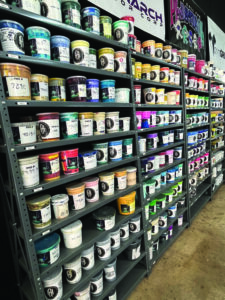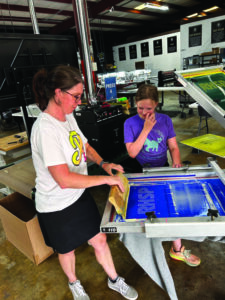If you’re looking for a way to make your apparel stand out, it’s time to revisit an old favorite that’s making a strong comeback — puff ink. This unique ink creates a fun, textured effect that adds dimension to your designs and sets your work apart from the competition. Let’s dive into some tips on how to master puff ink and bring this trend to life in your shop.
Materials matter
As with any screen-printing job, using the right materials is crucial to success. The first step in achieving a great puff print is choosing the right puff ink. At Rock Hill Screen Printing, our go-to is Avient Specialty Inks’ Nupuff base. It’s a consistent performer across various ink types, which is key when you’re working with different garments. Consistency helps you troubleshoot any issues that arise during printing — whether it’s with the garment or the ink.
Your screen choice is just as important. For puff ink, you’ll want to use a mesh count between 110 and 156, depending on the level of detail in your design. This will also help to ensure that you deposit enough ink for that all-important raised texture. Also, the right thread diameter minimizes any unwanted mesh marks on the finished print.
Choosing the right blank is another critical step. Since puff ink needs to cure at 320 F, cotton garments are ideal to prevent any dye migration. We’ve had great results with the Gildan 5000 and AS Colour staple tee. It’s worth experimenting with different brands to find the one that pairs best with your puff ink and delivers the results your clients expect. Remember, not all tees are created equal when it comes to specialty inks, so investing in quality blanks is key.
Artwork setup
 One aspect that’s often overlooked with specialty inks is the artwork setup. With puff ink, understanding how the ink behaves during curing is key. Puff ink acts as an underbase, so you’ll need to set up your colors with less choke to allow them to cover the expanding puff layer. If your artwork isn’t set up correctly, the final print might look out of registration, leading to unhappy customers.
One aspect that’s often overlooked with specialty inks is the artwork setup. With puff ink, understanding how the ink behaves during curing is key. Puff ink acts as an underbase, so you’ll need to set up your colors with less choke to allow them to cover the expanding puff layer. If your artwork isn’t set up correctly, the final print might look out of registration, leading to unhappy customers.
While puff additives can be tempting, I’d recommend sticking with a puff base. Once you mix puff additive into a batch of ink, that ink becomes a specialty item — one you might not use again, leading to wasted materials and increased costs. Plus, using puff as an underbase gives you more control over color adjustments, especially with the color muting that happens when the ink expands.
Troubleshooting tips
Puff ink is heat-activated, so if your print isn’t puffing up, the first thing to check is your curing temperature. The puff base needs to reach 320 F to activate fully. A donut probe is a handy tool to make sure your ink is hitting the right temp. If your temperature is correct but the puff effect is lacking, it could be that you’re not depositing enough ink. In that case, check your screen mesh and squeegee pressure.
Notice a glossy finish on your puff? That’s a sign of over-curing. If your puff has a dimpled appearance, inconsistent ink deposit might be the culprit. Try using a lower mesh count. And if you see screen grid marks in your puff, consider switching to a lower mesh count or a thin-thread screen. The thread diameter plays a big role here — the thinner, the better.
Mastering the technique
 Adding any specialty ink to your shop’s repertoire takes time and a bit of trial and error. Testing inks before they hit the press for a client job is a smart move — it gives you time to work out the kinks without the pressure of a deadline. Don’t hesitate to reach out to your local ink distributor or supplier for advice. They’re not just there to sell you ink; they’re also a valuable resource to help your shop improve.
Adding any specialty ink to your shop’s repertoire takes time and a bit of trial and error. Testing inks before they hit the press for a client job is a smart move — it gives you time to work out the kinks without the pressure of a deadline. Don’t hesitate to reach out to your local ink distributor or supplier for advice. They’re not just there to sell you ink; they’re also a valuable resource to help your shop improve.
Once you’ve nailed the technique, be sure to charge a premium for your expertise. The time you invest in mastering puff ink adds value to your shop, and you should be compensated for it. And don’t forget to advertise your new skill! Positioning your shop as a puff ink expert can only enhance your credibility in the industry. Whether it’s through social media, your website, or word of mouth, letting your clients know about your expanded capabilities can drive more business and set you apart as a leader in custom apparel.




